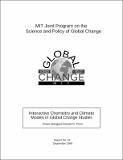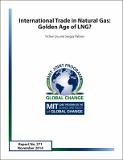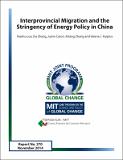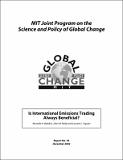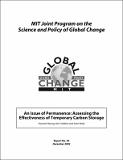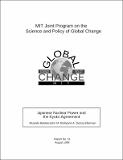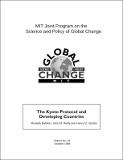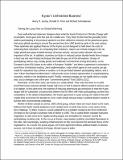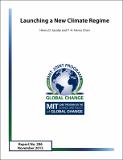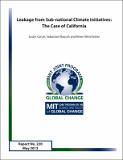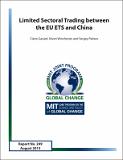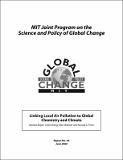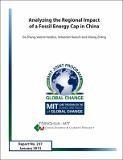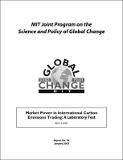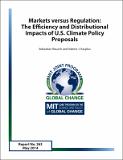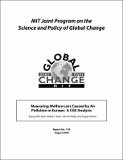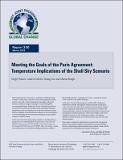Browsing Center for Global Change Science by Title
Now showing items 192-211 of 337
-
Interactive chemistry and climate models in global change studies
(MIT Joint Program on the Science and Policy of Global Change, 1999-09)Continually increasing atmospheric concentrations of radiatively important chemical species such as CO2, CH4, N2O, tropospheric O3, and certain halocarbons most likely will cause future climate changes, which could in turn ... -
International Trade in Natural Gas: Golden Age of LNG?
(MIT Joint Program on the Science and Policy of Global Change, 2014-11)The introduction of liquefied natural gas (LNG) as an option for international trade has created a market for natural gas where global prices may eventually be differentiated by the transportation costs between world ... -
Interprovincial Migration and the Stringency of Energy Policy in China
(MIT Joint Program on the Science and Policy of Global Change, 2014-12-02)Interprovincial migration flows involve substantial relocation of people and productive activity, with implications for regional energy use and greenhouse gas emissions. In China, these flows are not explicitly considered ... -
Is Current Irrigation Sustainable in the United States? An Integrated Assessment of Climate Change Impact on Water Resources and Irrigated Crop Yields
(MIT Joint Program on the Science and Policy of Global Change, 2016-11)While the impact of climate change on crop yields has been extensively studied, the quantification of water shortages on irrigated crop yields has been regarded as more challenging due to the complexity of the water resources ... -
Is international emissions trading always beneficial?
(2002-12)Economic efficiency is a major argument for the inclusion of an international emission permit trading system under the Kyoto Protocol. Using a partial equilibrium framework, energy system models have shown that implementing ... -
An issue of permanence: assessing the effectiveness of temporary carbon storage
(2002-12)In this paper, we present a method to quantify the effectiveness of carbon mitigation options taking into account the "permanence" of the emissions reduction. While the issue of permanence is most commonly associated with ... -
Japanese nuclear power and the Kyoto agreement
(MIT Joint Program on the Science and Policy of Global Change, 1999-08)We find that, on an economic basis, nuclear power could make a substantial contribution for meeting the emissions target Japan agreed to in the Kyoto Protocol. It is unlikely however that the contribution would be as large ... -
Joint implementation : lessons from Title IV's voluntary compliance programs
(MIT Joint Program on the Science and Policy of Global Change, 1997-06) -
The Kyoto Protocol and developing countries
(MIT Joint Program on the Science and Policy of Global Change, 1999-10)Under the Kyoto Protocol, the world's wealthier countries assumed binding commitments to reduce greenhouse gas emissions. The agreement requires these countries to consider ways to minimize adverse effects on developing ... -
Kyoto's Unfinished Business
(MIT Joint Program on the Science and Policy of Global Change, 1998-06)The authors offer a provisional assessment of where the Kyoto negotiations have left the climate change issue. They present a few widely divergent assesments of what the Kyoto Protocol on Climate Change will accomplish, ... -
Launching a New Climate Regime
(MIT Joint Program on the Science and Policy of Global Change, 2015-11)At the 2015 UN Framework Convention on Climate Change (UNFCCC) meeting in Paris, participants in a new international climate agreement will volunteer Nationally Determined Contributions to emissions reductions. To put the ... -
Leackage from Sub-national Climate Initiatives: The Case of California
(MIT Joint Program on the Science and Policy of Global Change, 2012-05-29)With federal policies to curb greenhouse gas emissions in the U.S. stagnating, California has taken action on its own. We estimate the impact of California’s cap-and-trade program on the leakage of emissions to other ... -
Limited Sectoral Trading between the EU ETS and China
(MIT Joint Program, 2013-08-21)In the negotiations of the United Nations Framework Convention on Climate Change (UNFCCC), new market mechanisms are proposed to involve Non-Annex I countries in the carbon markets developed by Annex I countries, beyond ... -
Linking local air pollution to global chemistry and climate
(MIT Joint Program on the Science and Policy of Global Change, 2000-06)We have incorporated a reduced-form urban air chemistry model in MIT's 2D-LO coupled chemistry-climate model. The computationally efficient reduced-form urban model is derived from the California Institute of Technology-Carnegie ... -
Marginal Abatement Costs and Marginal Welfare Costs for Greenhouse Gas Emissions Reductions: Results from the EPPA Model
(MIT Joint Program on the Science and Policy of Global Change, 2008-11)Marginal abatement cost (MAC) curves, relationships between tons of emissions abated and the CO2 (or GHG) price, have been widely used as pedagogic devices to illustrate simple economic concepts such as the benefits of ... -
Market Cost of Renewable Jet Fuel Adoption in the United States
(MIT Joint Program on the Science and Policy of Global Change, 2013-01)The US Federal Aviation Administration (FAA) has a goal that one billion gallons of renewable jet fuel is consumed by the US aviation industry each year from 2018. We examine the cost to US airlines of meeting this goal ... -
Market power in international carbon emissions trading: a laboratory test
(2003-01)The prospect that governments of one or a few large countries, or trading blocs, would engage in international greenhouse gas emissions trading has led several policy analysts to express concerns that trade would be ... -
Markets versus Regulation: The Efficiency and Distributional Impacts of U.S. Climate Policy Proposals
(MIT Joint Program on the Science and Policy of Global Change, 2014-05)Regulatory measures have proven the favored approach to climate change mitigation in the U.S., while market-based policies have gained little traction. Using a model that resolves the U.S. economy by region, income category, ... -
Measuring Welfare Loss Caused by Air Pollution in Europe: A CGE Analysis
(MIT Joint Program on the Science and Policy of Global Change, 2009-08)To evaluate the socio-economic impacts of air pollution, we develop an integrated approach based on computable general equilibrium (CGE). Applying our approach to Europe shows that even there, where air quality is relatively ... -
Meeting the Goals of the Paris Agreement: Temperature Implications of the Shell Sky Scenario
(MIT Joint Program on the Science and Policy of Global Change, 2018-04)The Paris Agreement makes long-term energy and climate projections particularly important because it calls for a goal that likely requires an energy system that is based on a radically different fuel mix than currently in ...
